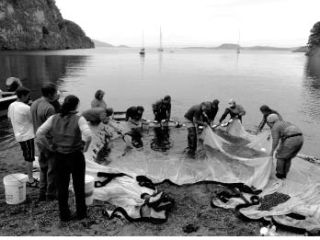Lopez scientists and volunteers have found sand lance, larval crabs, and insects all play crucial roles in the lives of juvenile Chinook salmon.
These salmon migrate through San Juan County.
Results were reported Jan. 15 at the third annual “Salmonation” event at Lopez Center.
For the past two years, volunteers working with the local nonprofit Kwiáht have focused on Watmough Bight and Cowlitz Bay, which appear to be the most productive bays in the county.
More than a thousand juvenile Chinook and Coho salmon have given up their lunch and a small fin clip for science.
Sand lance made up more than fourth-fifths of all the fish eaten by young Chinook. Sand lance are small, pencil-thin torpedo shaped fish that arrive in local bays each summer in swarms of hundreds of thousands.
Seabirds such as gulls, murres, and rhinoceros auklets also feed heavily on sand lance during summer. Relatively little is known about sand lance biology.
Most sand lance seem to live in sandy bay and channel bottoms in deep water, but swarm and feed close to the surface.
For reasons still unclear, they mass in some of the county’s more energetic bays from March to September, sometimes peaking in early summer, and in other years peaking in late summer.
In 2010, sand lance arrived a bit earlier and a bit smaller than in 2009, so more Chinook, and smaller Chinook, were able to feast on them. On the whole, juvenile wild Chinook ate better in San Juan County in 2010 than 2009.
Sand lance are not the whole story, however.
More than three-quarters of the prey items eaten by juvenile Chinook in 2009 and 2010 were invertebrates—small crustaceans and insects.
A majority of the crustaceans were larval crabs, which are associated with shallow bays where crabs mate and brood their eggs.
Most of the insects were midges and small flies that reproduce in wetlands and often swarm over open water. Over the course of the season wild Chinook obtained 80-20 percent of their calories from each fish, but on some days in late summer, young salmon relied on insects for 25-50 percent of their calories.
Individual salmon have different food habits, moreover. On any particular day of seining, volunteers found that individual fish had targeted as many as ten different kinds of prey in the same bay.
Last Aug. 6, for example, volunteers collected stomach contents from 43 young wild Chinook.
Fifteen had eaten sand lance and five had eaten herring. They were the best fed of the 43 in terms of total calories. The rest had just eaten invertebrates.
Project coordinator Russel Barsh told the audience at Salmonation that Chinook seem to be divided, like people, into risk-takers and risk-avoiders.
Risk takers go after sand lance and other fish, which are big package of calories but difficult to capture; risk-avoiders eat small but easy-to-catch invertebrates.
Weekly increases in the size of juvenile Chinook, and recaptures of salmon previously caught and clipped, suggest to Barsh that a large number of these fish spend weeks to months in the San Juan islands.
Now in its fourth year, the project will continue monitoring the diet and health of juvenile wild Chinook at Watmough and Cowlitz.
Those participating in the program will try to learn more about the timing and movements of sand lance in the islands. One method of doing this is to tag the salmon.
In addition, Lopez student Kelley Palmer-McCarty is organizing volunteers for a study of the seabirds that compete with salmon for sand lance on the south end.
Islanders interested in volunterering can contact Palmer-McCarty or Barsh at fishermanbay@me.com.





